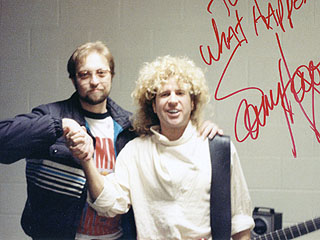Although I mentioned the changes several weeks ago, starting tomorrow I will be doing “One Hit Wonder Wednesdays,” “Flipside Fridays,” and “Bubbling Under Saturdays.” The other features, “Spiritual Sundays,” “Monday Covers,” “Traditional Tuesdays,” and “TV Thursdays” will continue for some time, but I probably will be switching some of these out later in the new year.
So as my last post for 2010 (which by the way is number 450), I pay homage to two of my friends with whom I reconnected with on Facebook this year. On my 55th birthday, Barry Pendry, who was Barry Stewart on WCIR-FM when I first joined the staff in 1981, told me I should have featured the song “Ol’ 55” on that particular day. It certainly made sense, but it hadn’t even crossed my mind.
This week, my old college friend and frequent source of song inspiration for this blog, Greg Rector asked me if I would do a tune from Tom Waits. So today, I will be doing both, as Waits was the author and original artist of the song that is probably better known as an Eagles’ recording. It begs the question: “Is it a breath mint or a candy mint? It’s two mints in one.”
In fact, in addition to a version by the Eagles, I’ll be featuring three versions by Waits: his original release, his original recording, and a later live recording done in a style that most Waits aficionados are most familiar. Warning: if you are not familiar with Tom Waits, you may not like his music. Much like other musical geniuses (namely Bob Dylan and Johnny Cash), he is an acquired taste. Not everyone will appreciate his approach, his style, or most of all his vocal prowess.
I first became aware of Waits during the summer of 1976 and I used to have a life size stand-up of Waits in my living room when I was single. It was the store promo for his “Small Change” LP that was my brother’s until he got married and had to divest of it – lest he incur certain wrath. Married men everywhere will certainly understand and appreciate the reason why.
By the time I married, it had literally fallen apart due to the humidity. Knowing that it wouldn’t have a place ever in our living room and the display wasn’t worth fixing, I trashed it. A wise decision – but I still miss Waits’ ever present watch over my domain. I have several pictures of Waits in my home then, but alas these are all in storage at the present time in anticipation of a move to our latest domain.
Tom Waits’ Original Release
While not his first recording of the song, it was the first release of “Ol’ 55.” From his 1973 “Closing Time” album, you can see how The Eagles’ version was inspired by Waits’ original. It is not, however, in the manner that has grown to be his received performance style. This rendition may be a little bit of a shock to Eagles fans as his harmonies are not as clean as theirs. I think Waits referred to the Eagles’ recording as being a “little too antiseptic for his tastes.” I'm sure he appreciated the royalties though.
Tom Waits’ Original Recording
Released in 1993 as part of Waits’ “The Early Years, Volume Two,” Waits accompanies himself on guitar for “Ol’ 55” rather than on his characteristic piano (which sometimes has been accused of drinking). “Ol’ 55” was one of the songs Waits recorded as part of his demo for Frank Zappa’s Bizarre and Straight record labels. It is an interesting piece of history from 1971 and in some ways I prefer it to his version from “Closing Time.”
Tom Waits’ Live Recording
Although the accompanying version is from 1999, it is the live style that most Waits fans would recognize and one that he had developed by the time of his third album release “Nighthawks at the Diner.” I always thought the “Ol’ 55” was a Chevy, but Waits informs us that it actually was a Caddy.
Eagles’ Live Recording
You will be hard pressed to find a studio version of any recording on a WEA (Warner/Elektra-Asylum/Atlantic) label on YouTube due to Warners’ strict prohibition of their recordings being offered online for free. Expect the first version by Waits to disappear soon from YouTube as it, like the Eagles’ recordings, was released on Asylum Records.
In the absence of the Eagles’ studio rendition from the 1974 “On the Border” LP, here is a live version from from “Don Kirshner’s Rock Concert” during the same year. Glen Frey handles the piano and lead vocals while Don Henley provides the high vocal parts and the high harmony.
Happy New Year all.


















